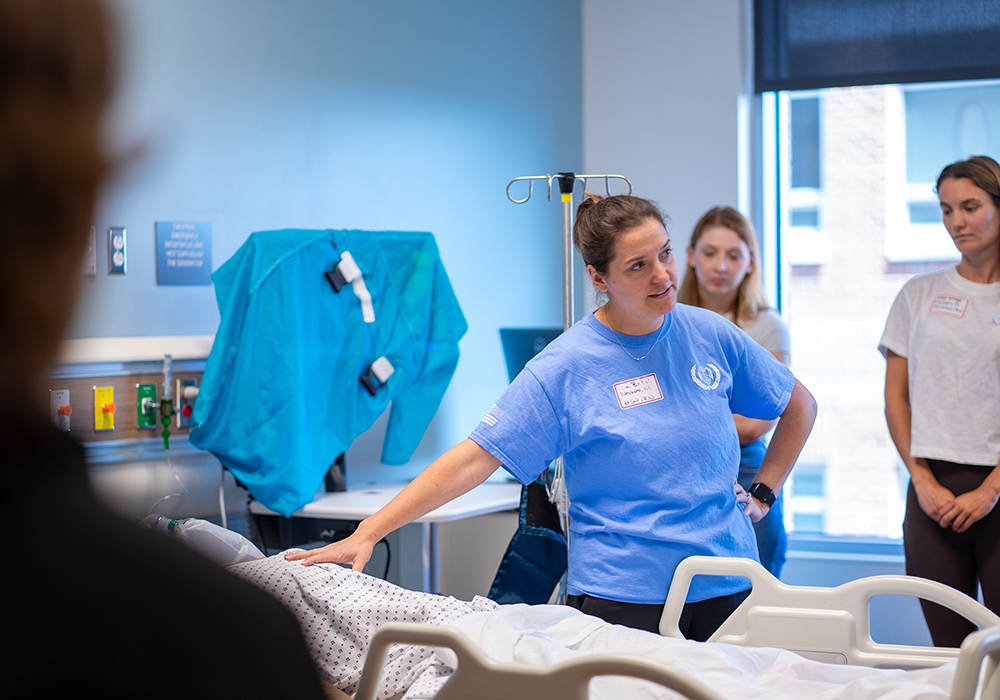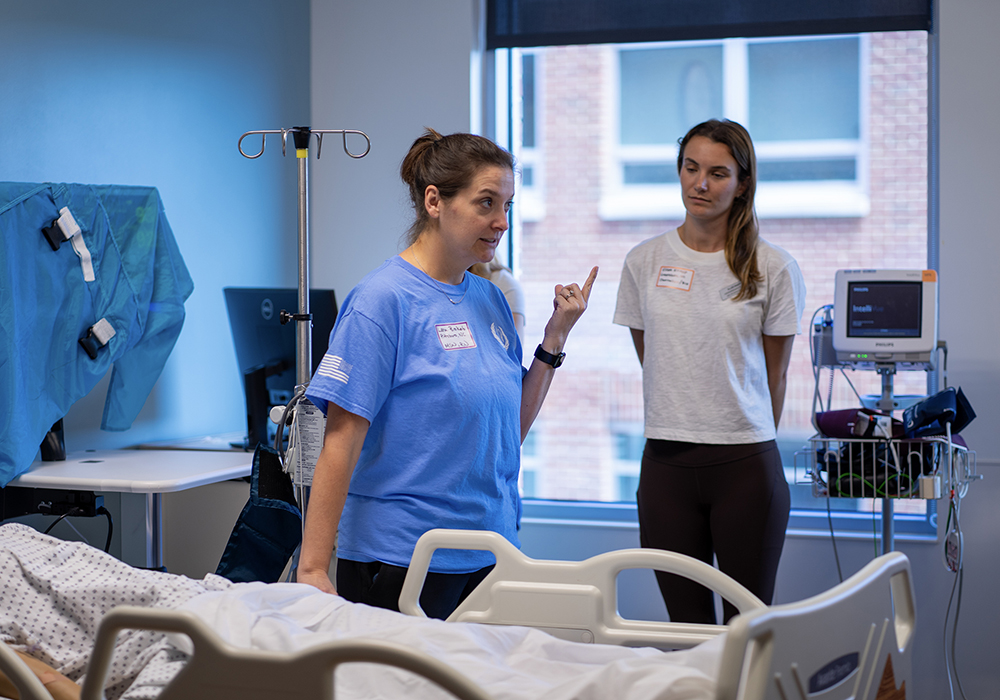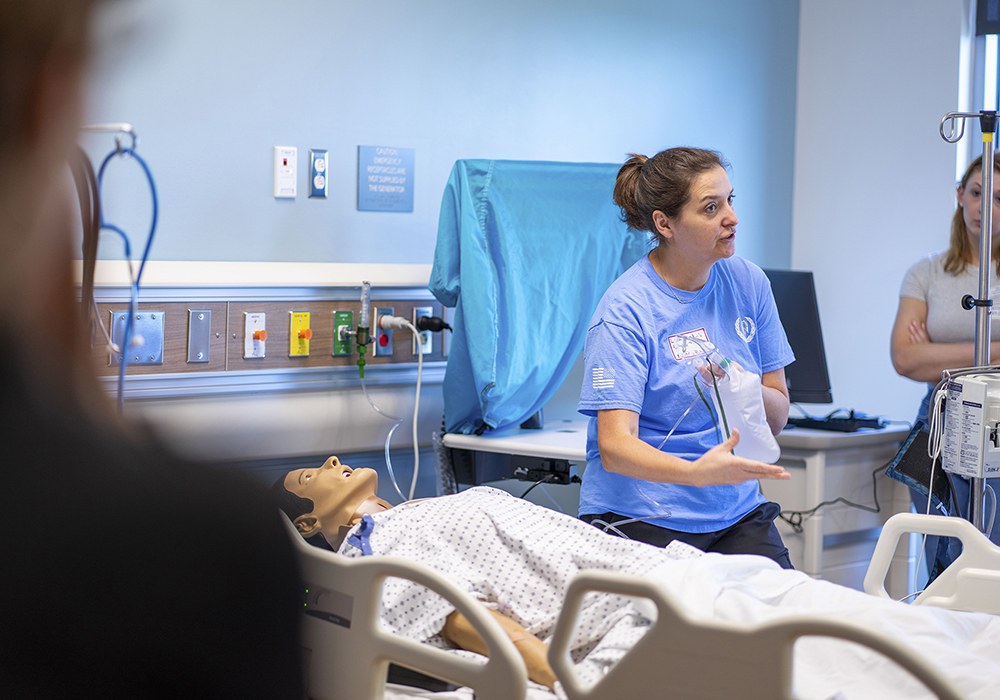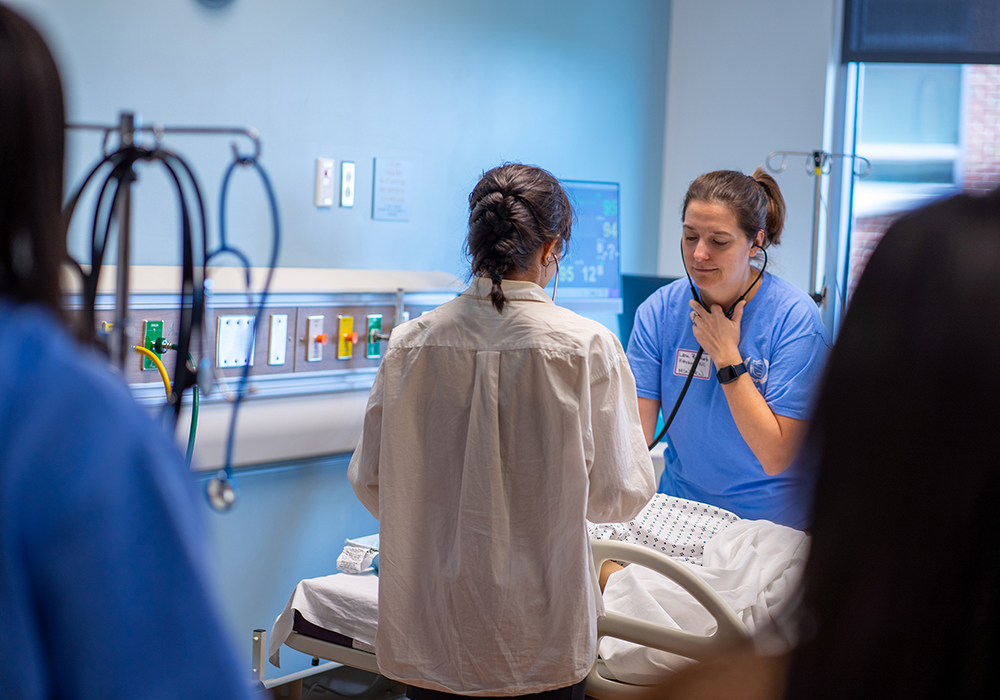Emerging Technologies in Oncology Nursing
Today’s technologies are tools that oncology nurses can use to transform cancer care—for their practice as well as their patients. Although the latest technologies are in a state of constant evolution, oncology nurses can take a leading role in guiding their application to and implementation in health care and cancer care.
AI in Nursing Education
ONS member Marlena Brokob, DNP, RN, a clinical instructor at the University of North Carolina at Chapel Hill, uses generative artificial intelligence (AI) to enhance her lectures, improve assignments and rubrics, and create case studies. She said she first took the plunge into AI after her brother introduced her to ChatGPT (which stands for chat–generative pretrained transformer) in January 2023. After talking about it with another nurse educator who was familiar with the tool, Brokob said she took a “deep dive into learning how to use it best,” using Coursera courses developed by Vanderbilt University (https://news.vanderbilt.edu/2023/05/24/vanderbilt-launches-free-online-chatgpt-course-shaping-the-future-of-ai-education/).
“I used it first to fix and streamline my lecture material to make it more linear,” Brokob said. “My brain is neurodivergent, so I typically struggle with linear thinking. Using ChatGPT to help me map a course curriculum in a logical, linear way was super helpful for my summer oncology nursing elective.”

She compared it and other emerging technologies to the advent of the internet in the 1990s: It requires some considerations and adjustments. For example, she said that nurses must maintain a healthy level of skepticism and spirit of inquiry to assess a tool’s appropriateness for practice. Nurses should not just proceed with what the system generates without first vetting it. However, she believes that, eventually, generative AI will become a commonly used approach.
“Just like social media and other technologies before it, these technologies are made and programmed by fallible humans, so it’s important to remember the critical motto I teach: Trust but verify,” Brokob said.
Brokob co-presented a poster, “Embracing AI: Assessing the Knowledge and Comfort of Oncology Nursing Students With Artificial Intelligence (https://ons.confex.com/ons/2024/meetingapp.cgi/Paper/14559),” at the 49th annual ONS Congress® in April 2024. She and her colleagues discussed how their study findings showed that “students and educators were leery or uncomfortable at first with all the negative news about generative AI, but once they got involved with it, they realized that generative AI is what the introduction of the World Wide Web was to my generation (as an elder millennial),” Brokob said.
Today, as Brokob described it, “everyone is walking around with the entire human race’s knowledge as we know it in their pockets,” so the internet fear from her youth was “a little shortsighted in hindsight.” She encouraged nurses to use the same perspective for generative AI and said she sees it as “an excellent way for students to convert medical terms and concepts into a health literacy level appropriate for various patients.” This is the second summer that Brokob has used generative AI with her students, and she described it as “a great equalizer in communication.”
GPT-based assistants can even create simulated patients with whom nurses can interact and then receive feedback on how well they provided therapeutic communication (https://www.ncbi.nlm.nih.gov/pmc/articles/PMC10828948/), Brokob said. Some nurse educators also use it to help nurses simplify challenging concepts and brainstorm essay outlines or research ideas (see the sidebar for an example ChatGPT prompt Brokob has used). Finally, AI can be used to teach nurses how to find faults, errors, and biases in the AI-generated responses that a patient may encounter.
“The most significant aspect of using generative AI to help us as oncology nurses is how it explains medical jargon to the everyday person,” Brokob said. “I have used it myself to help decipher commonly used healthcare words to better explain what is happening with my patients. Having a medical background helps to ensure that the output is correct.”
She also uses it to come up with questions that patients can ask their medical team. She encouraged everyone to use it a little bit each day. “It’s not time-consuming, and you’ll be surprised how much you can do and learn.”
New Technologies in Clinical Practice
Generative AI is just the proverbial tip of the iceberg of new tools at nurses’ fingertips to enhance patient care and efficiency. For example, Kaiser Permanente is partnering with Innovacer, an AI platform that brings together (https://medcitynews.com/2024/05/kaiser-permanente-innovaccer-healthcare-technology/) patient data from various sources to provide a more complete picture of a patient’s health. Mayo Clinic just announced (https://www.prnewswire.com/news-releases/exer-ai-collaborates-with-mayo-clinic-to-advance-standard-of-care-for-hand-and-wrist-disorders-with-ai-302238869.html#:~:text=DENVER%2C%20Sept.%205%2C%202024,chronic%20hand%20and%20wrist%20disorders) a collaboration with Exer AI, which uses the technology to diagnose and treat disorders specific to hands and wrists by conducting remote assessments using biomarkers rather than wearables to measure, assess, and monitor patient movement. Technologies like these are expanding our imagination for the future with the incredible number of tools currently being evaluated (https://arxiv.org/pdf/2402.01077) for use in health care.
“New innovations give providers easy access to data, analytics, and other decision support tools to enable them to make data-driven—and often personalized—decisions during patient care delivery,” ONS member Abigail Baldwin Medsker, MBA, MSN, RN, senior director of emerging digital programs, health informatics, at Memorial Sloan Kettering Cancer Center (MSKCC) in New York, NY, said.
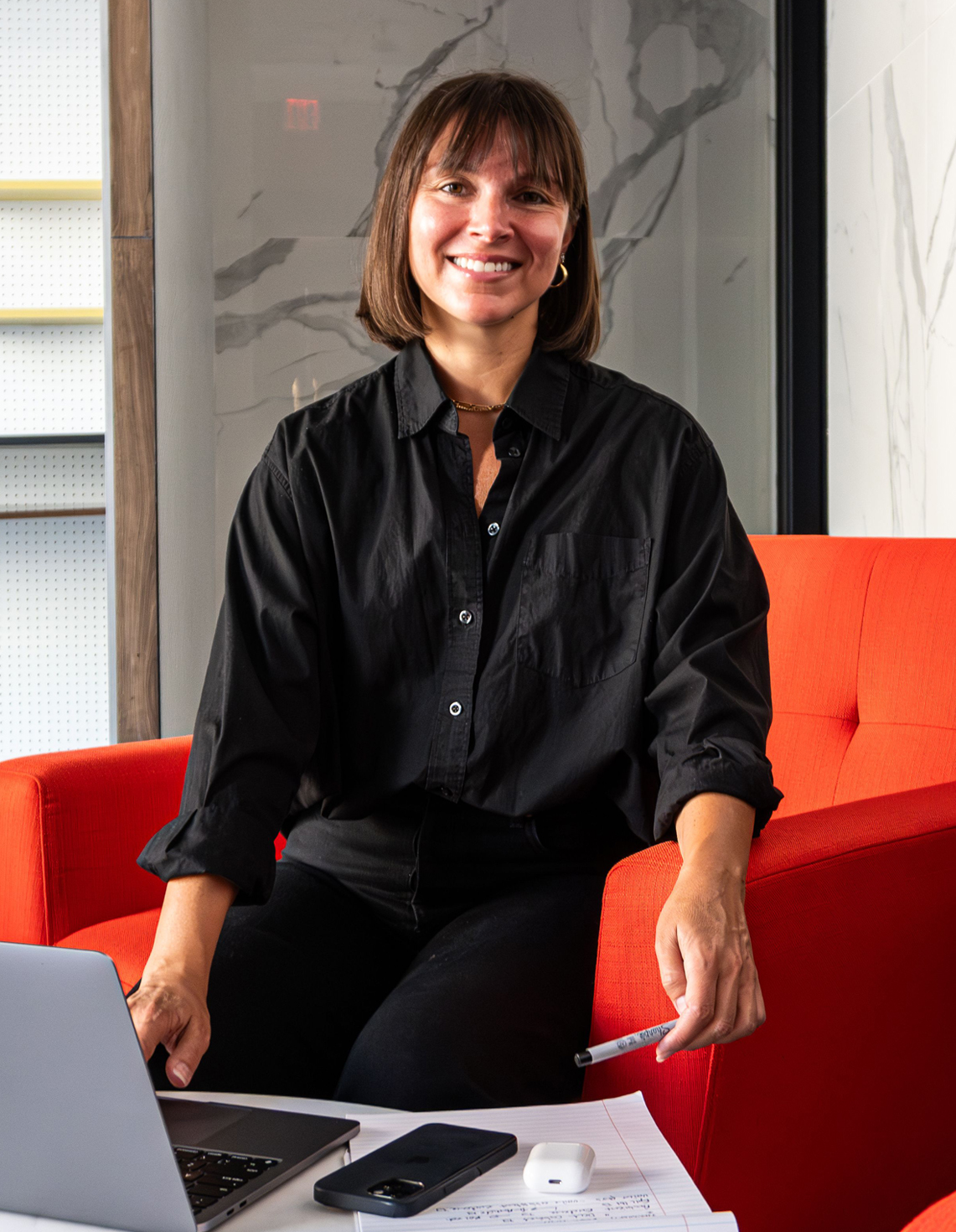
Ambient technology (https://www.mgma.com/mgma-stat/ambient-technologys-role-in-the-ai-revolution) is one of the trends she said she is especially excited about because of its ability to create efficiencies for nurses during the documentation process. She explained that the technology uses voice recognition to securely listen to an interaction between a clinician and patient, then uses generative AI to summarize the interaction. Studies (https://www.sciencedirect.com/science/article/pii/S2514664524015479) indicate the tool can improve documentation quality, a common limitation (https://catalyst.nejm.org/doi/full/10.1056/CAT.23.0404) of electronic health records.
“Ambient solutions have been proven to decrease the time it takes to document care delivered while also providing a tool that enables nurses to spend more quality, face-to-face time with patients and families during their encounters,” Medsker said. She said her organization is piloting the technology with physicians, physician assistants, and nurse practitioners and plans to develop a solution for nurses as well.
Other advancements include AI-driven clinician decision support (CDS) tools and risk modeling tools. CDS tools can be used at the point of care to assist with making informed, evidence-based decisions. Use cases that MSKCC has studied include predicting prognosis on admission, identifying drug interactions, and alerting clinicians of patients’ risks for falls.
Medsker said that her organization developed a CDS tool (https://doi.org/10.1055/s-0044-1787185) that helps clinicians estimate the probability of patient mortality within 45 days of hospital admission with high-risk cancers. They found it helped (https://doi.org/10.1055/s-0044-1787185) clinicians initiate end-of-life care discussions earlier on with appropriate patients. They are also using AI in radiation oncology to assist with treatment planning.
“The oncology nursing space is ripe for innovation,” Medsker said. “There are many opportunities to use innovative technologies to provide efficiencies for nurses, enabling them to spend more time with patients and families providing nursing care.”
A risk modeling tool can similarly analyze data to predict a patient’s disease or symptom risk (https://doi.org/10.1038/s41467-020-17431-x) and inform appropriate personalized testing and management. For example, Medsker was one of the investigators on a 2020 study (https://ascopubs.org/doi/full/10.1200/CCI.19.00104?role=tab) that demonstrated clinically relevant results of a risk prediction model that helped to identify which patients receiving antineoplastics were at a high risk for a preventable acute care visit.
Administrative workflows can be made easier with new technologies as well. AI-based systems can assist with nurse scheduling (https://voice.ons.org/news-and-views/05-2024/innovative-solutions-to-maximize-oncology-nurse-staffing-during-a-nursing) and other operational workflows. Medsker said her organization is currently piloting a solution to help with administrative tasks such as capturing meeting minutes, taking notes, conducting market research, drafting emails, and supporting contracting and financial processes.
“The oncology nursing space is ripe for innovation,” Medsker said. “There are many opportunities to use innovative technologies to provide efficiencies for nurses, enabling them to spend more time with patients and families providing nursing care.”
Considerations for Patients and Nurses
Brokob encouraged nurses who are interested in generative AI, such as ChatGPT or Microsoft’s Copilot, to learn how the tools work before trusting that the output is reliable (see ONS Voice’s “What Does ChatGPT Say About Emerging Trends in AI and Other Oncology Nursing Technologies?”). Generative AI chatbots use natural language processing (https://hbr.org/2022/04/the-power-of-natural-language-processing) to create humanlike dialogue, which makes them sound confidently authoritative on the surface. However, they are known to have critical limitations such as the propensity for hallucinations and bias (https://mitsloanedtech.mit.edu/ai/basics/addressing-ai-hallucinations-and-bias/), so Brokob encouraged nurses to fact-check any generative AI output carefully before sharing it with others.
“There isn’t a single time I felt that the output could have been better to use without reviewing and repeatedly fixing its errors,” she said. “It’s not meant to be used that way. It's meant to be an idea generator, used with my ideas and thoughts.” Brokob added that interacting with AI is iterative, meaning that a user must continually review and repeat queries, refining their feedback in the process.
She said a poor prompt can result in very bad responses, comparing it to asking a new employee to do a task on their very first day without fully explaining the task. For example, one tip she’s learned when seeking accurate sources is to ask ChatGPT to pull its references from PubMed.
Nurses must also understand that because current generative AI tools pull their data from the entire internet, not all of the sources are evidence based. Accordingly, it can also reproduce bad responses or repeat inaccurate information that may be biased or stereotyped. “Whenever a new technology is developed, there is a bias,” Brokob said. “But one thing I like about generative AI is that when it produces output that we see as perpetuating a stereotype, we can ask it not to do this. We can use it as a teaching moment.”
She also pointed out that humans, not machines, are the root of the problem.
“Acknowledging that we are the ones creating these biases and that AI is picking up on these trends is a concern we should continue to worry about and try to improve,” Brokob said. “When I ask AI to give me an image of a nurse, it often provides a picture a white female nurse in a white uniform. To counteract this, I must be more descriptive in my prompt and ask for diverse or nonstereotypical representations of nurses.”
One concern about technologic advancements from a patient’s perspective is the “digital divide,” in which patients without access to technology may have poorer outcomes (https://link.springer.com/article/10.1007/s11920-021-01274-4). Medsker represented her organization on the CancerX (https://cancerx.health/about-cancerx/) Moonshot project to develop digital-first resources (https://cancerx.health/improve-equity/) to support the cancer community. The resources include a digitally enabled patient navigation blueprint (https://cancerx.health/improve-equity/patient-navigation-blueprint/), which is designed to improve access to care and reduce financial toxicity.
“It’s a very exciting time for oncology nurses and nursing leaders to work side-by-side with their technology teams designing, developing, and implementing solutions that meet the needs for nurses and our patients and families,” she concluded.
Learn how oncology nurses are contributing to opportunities to shape in AI in health care on the Oncology Nursing Podcast™ Episode 281: Nursing’s Role in AI in Health Care (https://www.ons.org/podcasts/episode-281-nursings-role-ai-health-care). Listen on your favorite podcast platform or using the player below.

